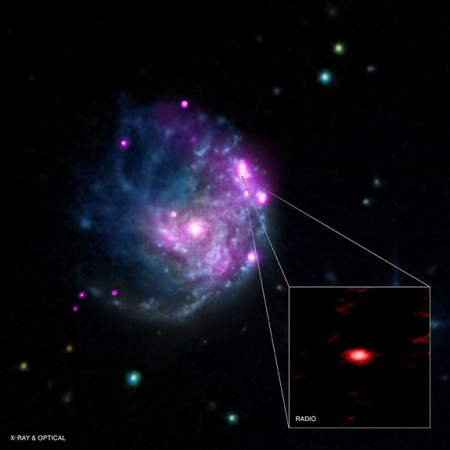
Astronomers believe they have discovered a rare type of black hole that could provide insight into the evolution of black holes. The research study, which investigated a newly identified object situated in the NGC 2276 galaxy, was conducted by scientists from the University of Durham in the United Kingdom.
“In paleontology, the discovery of certain fossils can help scientists fill in the evolutionary gaps between different dinosaurs,” stated Harvard-Smithsonian Center for Astrophysics researcher Mar Mezcua. “We do the same thing in astronomy, but we often have to ‘dig’ up our discoveries in galaxies that are millions of light years away.”

Located some 100 million light years from Earth, the mysterious object in question, called NGC2276-3c, is an intermediate-mass black hole (IMBH) in the spiral galaxy NGC 2276. IMBH-type black holes are intermediates between much smaller black holes - which typically have between five and thirty times the mass of the sun - and supermassive black holes. Supermassive black holes are estimated to weigh in at millions or billions of times higher than the mass of the sun. Intermediate-mass black holes, meanwhile, have masses anywhere between hundreds of solar masses and hundreds of thousands of solar masses.
IMBHs are of particular interest to astronomers, since they could represent the antecedents, or galactic “seeds,” of supermassive black holes. Until now, these mid-sized black holes have proven elusive.
“Astronomers have been looking very hard for these medium-sized black holes,” explained co-author Tim Roberts in a recent press release. “There have been hints that they exist, but the IMBHs have been acting like a long-lost relative that isn’t interested in being found.”
The team used the Chandra X-Ray Observatory and the European Very Long Baseline Interferometry (VLBI) Network to look at the X-ray and radio wave emissions from NGC2276-3c, respectively. From this data, the team calculated the mass of the IMBH to be around 50,000 solar masses.
According to co-author Andrei Lobanov, the black hole possesses some properties of stellar-mass black holes and some characteristics of the monster-sized supermassive black holes. On this basis, Lobanov and colleagues argue that NGC2276-3c helps astronomers “… tie the whole black hole family together.”
Intriguingly, the team also discovered a radio jet that projected upwards to approximately 2,000 light years. Within the first 1,000 light years of this stream, however, there are no young stars, indicating that the jet has pushed out gas clouds that, if present, would have condensed to form nascent stars.
In a separate study on NGC 2276, a different research team established that there was a high rate of star formation - between five and 15 stars per year. This suggests the galaxy very recently collided with a nearby dwarf galaxy.
